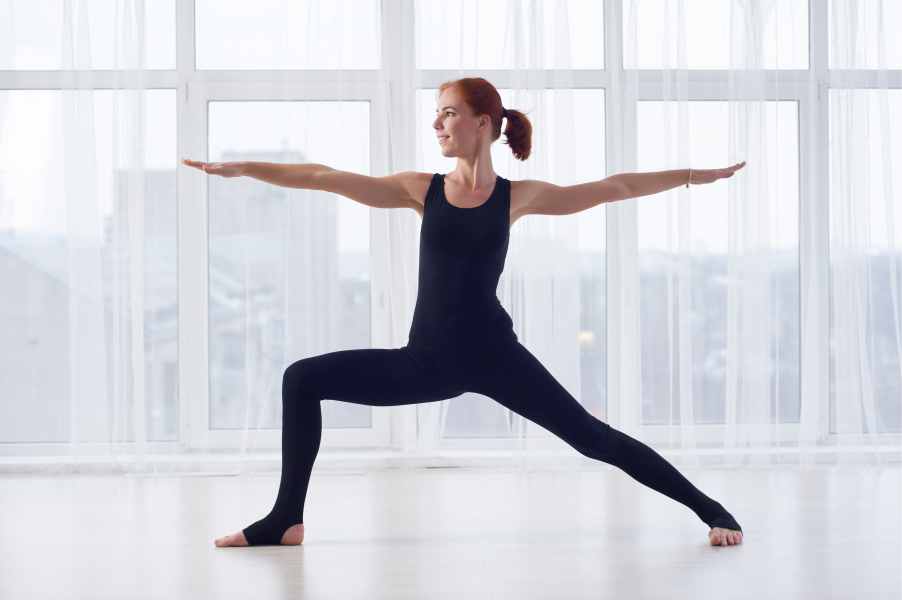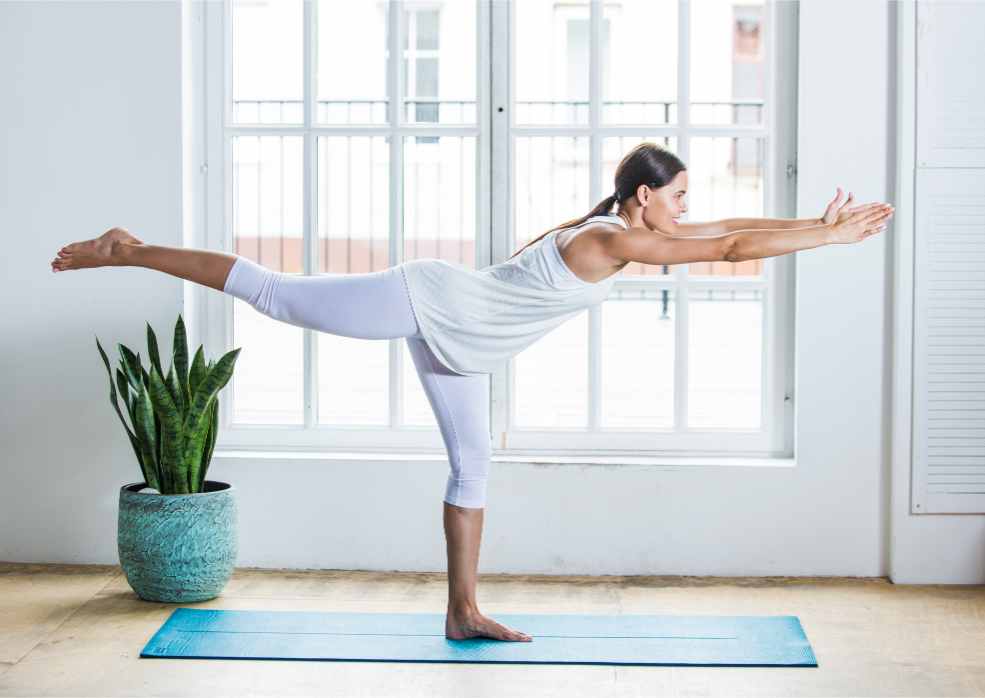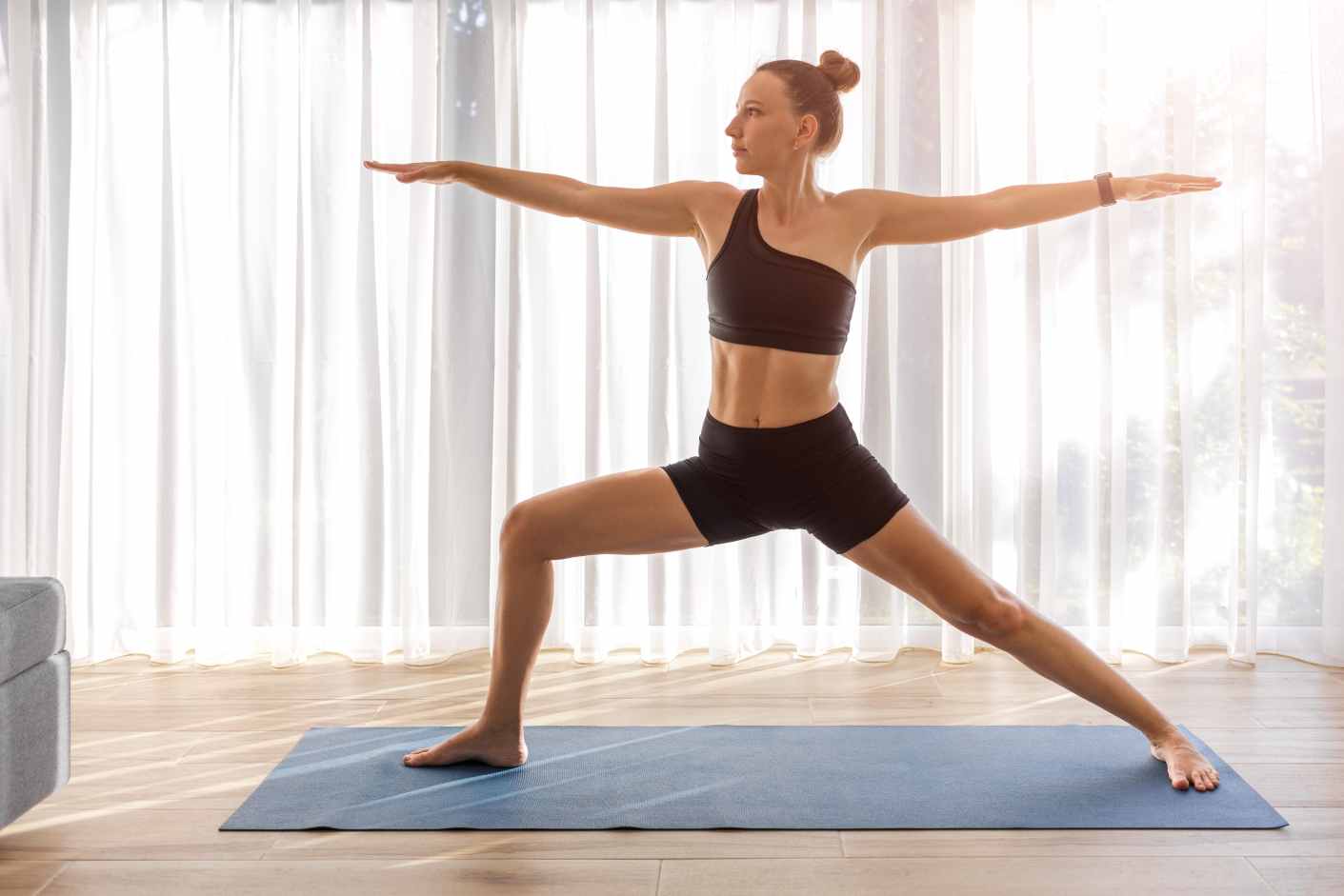How to Perform Warrior Pose (Virabhadrasana) & its Health Benefits

The warrior pose, also known as Virabhadrasana, is a foundational asana in yoga practice that builds strength, flexibility, and concentration. It engages multiple muscle groups, including the legs, core, and arms, and promotes stability and endurance. It is often included in various yoga sequences and can be adapted for different levels of practice.
What is Warrior Pose (Virabhadrasana)?
The Virabhadrasana series or vira postures are the names of the five warrior poses in Indian yogic tradition. These are standing postures that individuals typically need to do in succession and are frequently incorporated into Vinyasa-style sessions and Sun Salutations with modifications.
These postures bear the name of Virbhadra, a mythological warrior created by the deity Shiva. This demanding sequence of yoga positions stretches and strengthens our bodies, souls, and minds. The Virabhadrasana sequence is the most well-known and beneficial set of yoga poses.
Yoga Level: Intermediate
How to Perform Warrior Pose?
Step 1: Begin by standing in the mountain pose or Tadasana, and with your right leg, take a big step back. Place your right foot in the back, facing outward at a 45-degree angle. The left foot should be placed in front, facing forward.
Step 2: This step requires the front knee to be bent directly above the ankle.
Step 3: Roll your shoulders down and away from the ears while raising your arms above the head with your hips facing forward.
Step 4: Step the rear left foot forward and return to Tadasana after five breaths. Continue with your opposite leg.
What are the Safety Precautions to Take While Performing Warrior Pose?
To reduce the risk of muscle strain, ensure your body is warmed up with light stretching or a gentle yoga sequence before attempting the warrior pose.
Pay close attention to the alignment of your knees, hips, and spine.
Activate your core muscles to support your lower back and maintain balance.
Who Should Avoid Practising Warrior Pose?
If you have recently injured your knees, hips, ankles, or back, you must avoid the warrior pose until you fully recover.
Individuals with chronic joint pain, such as arthritis, especially in the knees or hips, may find the warrior pose uncomfortable or challenging.
Some variations of the warrior pose involve raising the arms overhead, which can increase blood pressure.
Variations of Warrior Poses
Warrior pose, a staple in yoga, comes in several variations, each offering unique benefits for strength, stability, and mental focus. From Warrior I to Warrior III, these poses embody grace, power, and resilience on the mat.
1. Warrior II (Virabhadrasana II)

Warrior II, or Virabhadrasana II, is a foundational yoga pose known for its grounding stance and graceful arm extension. It strengthens the legs, opens the hips, and cultivates a sense of inner strength and determination.
Yoga Level: Beginner
How to Perform Warrior II?
Step 1: Take a broad step back with the right leg in Tadasana. The front left foot should be pointing forward, and the right foot should be at the back at a 45-degree angle to the outside.
Step 2: In this step, keep your front knee bent so that it sits squarely over the ankle.
Step 3: While maintaining your focus on the front right hand, extend your arms horizontally to the floor so that your front right arm faces forward directly above your front right leg and your back left arm faces back directly above your back left leg.
Step 4: Keep your shoulders rolling back and away from your ears.
Step 5: Step your left back foot forward and return to Tadasana after five breaths. Repeat on the opposite leg, with the left arm extended forward.
What are the Safety Precautions to Take While Performing Warrior II?
- Keep a slight bend in the elbows and soften the shoulders away from the ears to avoid locking the joints of the front leg or straining the shoulders.
- Pay attention to any discomfort or pain, especially in the knees, hips, or shoulders.
- To promote relaxation and focus, maintain steady and deep breathing throughout the pose, avoiding breath-holding or shallow breathing.
Who Should Avoid Practising Warrior II?
- To prevent exacerbation, individuals with recent knee, hip, or shoulder injuries should avoid or modify the Warrior II pose until they fully recover.
- Those with chronic joint issues, such as arthritis or tendonitis, especially in the knees, hips, or shoulders, may find the Warrior II pose uncomfortable or exacerbating.
- Some variations of Warrior II involve raising the arms overhead, which can increase blood pressure.
2. Warrior III (Virabhadrasana III)

Warrior III, or Virabhadrasana III, is a challenging yoga pose that requires balance, strength, and focus. In this asana, the body forms a straight line from the extended back leg to the outstretched arms, resembling a graceful and powerful warrior in flight.
Yoga Level: Intermediate
How to Perform Warrior III?
The steps to do Warrior III pose include:
Step 1: Bend forward at the hips from the mountain pose, keeping your back straight. Extend your arms in front of you and lift your right leg behind you.
Step 2: Maintain a forward bend with your hips facing the floor until your outstretched arms and legs parallel the ground.
Step 3: To return to Tadasana, stand up straight after five breaths and step your right back leg next to your left. Continue with the opposite leg.
What are the Safety Precautions to Take While Performing Warrior III?
- Before attempting warrior III, ensure your body is warmed with gentle stretches and movements to prepare the muscles and joints.
- Begin by rooting down through the standing foot, spreading the toes wide for stability, and engaging the muscles of the standing leg to maintain balance.
- Activating the core muscles stabilises the torso and pelvis, helping prevent strain on the lower back and promoting balance.
Who Should Avoid Practising Warrior III?
- Those with chronic balance issues, vertigo, or inner ear disorders should approach the warrior III pose with caution.
- Some variations of warrior III involve raising the arms overhead, which can increase blood pressure.
- Individuals who have undergone recent surgery, particularly in the lower body or abdomen, should avoid the warrior III pose.
3. Reverse Warrior Pose (Proud Warrior/Crescent Pose)

Reverse warrior pose, also known as proud warrior or crescent pose, is a dynamic yoga asana that combines a deep side stretch with a gentle backbend. In this pose, the body extends gracefully to one side while the opposite arm reaches overhead, creating a stretch along the side of the body and opening the chest.
Yoga Level: Beginner
How to Perform Reverse Warrior Pose?
The steps to do this pose are:
Step 1: While staying in Tadasana, step the right leg far back. Your front left foot should point forward, and your back right foot should be at a 45-degree angle to the outside.
Step 2: Bend your front knee until it is over the ankle.
Step 3: Slide the right hand as far down as it will go on the right thigh. Raise your left arm over your head, palm facing backwards, with the hips pointing forward.
Step 4: Recline your spine while bending backwards, keeping your shoulders down and away from the ears.
Step 5: After taking five breaths, step your left foot in reverse and return to Tadasana. As you repeat on the other leg, alternate the arms.
What are the Safety Precautions to Take While Performing the Reverse Warrior Pose?
- Ensure a stable foundation by grounding through the feet and engaging the legs, particularly the inner thighs and outer hips muscles, to support the posture.
- Activate the core muscles to support the lower back and pelvis, helping to stabilise the spine and prevent overarching in the lumbar region.
- Maintain steady and deep breathing throughout the pose to promote relaxation and enhance the stretch. Avoid holding your breath or breathing shallowly.
Who Should Avoid Practising Reverse Warrior Pose?
- Pregnant individuals, especially those in the second and third trimesters, should exercise caution when practising reverse warrior pose.
- Individuals with balance issues, vertigo, or inner ear disorders should approach the reverse warrior pose with caution, ensuring they have proper support and stability.
- Some variations of the reverse warrior pose involve raising the arms overhead, which can increase blood pressure.
4. Humble Warrior (Bound Warrior/Devotional Warrior)
Humble warrior, also known as bound warrior or devotional warrior, is a variation of the traditional warrior pose that incorporates a deep forward fold and arm binding behind the back. This challenging yoga asana combines strength, flexibility, and surrender, fostering humility and opening the heart centre.
Yoga Level: Intermediate
How to Perform Humble Warrior Pose?
Follow these steps to perform this yoga pose:
Step 1: Begin to perform Tadasana by taking a significant step back with your right leg. The front left foot should be pointing forward, and the back right should be at a 45-degree angle to the outside.
Step 2: Bend your front knee until it is over the ankle.
Step 3: Keep your hips forward while rolling the shoulders back and down. Your hands should be behind your back, making a fist.
Step 4: Begin to bend forward from your waist until your head is positioned on the inside of the knee and your arms are raised as high as they will go. Turn your torso away from the front leg just a little.
Step 5: After five breaths, return to Tadasana by lifting the torso and stepping the left back foot forward. Then, move on to the other leg.
What are the Safety Precautions to Take While Performing the Humble Warrior Pose?
- Prioritise a thorough warm-up to prepare your body for the pose, focusing on stretching the hips, shoulders, and spine.
- Ensure a stable foundation by grounding through the feet and engaging the legs, particularly the muscles of the thighs and hips, to support the posture.
- Flexibility in the hips is essential for lowering the torso towards the inside of the front thigh.
Who Should Avoid Practising Humble Warrior Pose?
- Those with severe restrictions in hip mobility or hip-related injuries may find the humble warrior pose uncomfortable or challenging.
- Pregnant individuals, especially those in the second and third trimesters, should exercise caution when practising the humble warrior pose.
- Those with limited mobility or range of motion in the shoulders may find binding the hands behind the back challenging.
Benefits of Doing Warrior Pose
Warrior pose, a yoga staple, offers many benefits for physical and mental well-being. It is a versatile pose with holistic advantages, from strengthening and toning muscles to promoting relaxation and mental clarity.
- Strengthens and Tones Muscles: Warrior pose targets the arms, legs, and lower back, effectively building muscle strength and definition throughout the body and promoting overall physical stability and power.
- Enhances Posture: By engaging key muscle groups and promoting spinal alignment, warrior pose helps improve posture, reduce the risk of slouching or misalignment, and lead to a more confident and poised appearance.
- Stimulates Stamina: Practising warrior poses regularly can boost stamina and endurance levels, allowing you to sustain physical activity for extended periods and increase overall energy levels throughout the day.
- Relieves Shoulder Tension: The expansive arm movements in the warrior pose help release tension and stress in the shoulders and upper back, promoting relaxation and alleviating discomfort.
- Improves Muscle Flexibility: Warrior pose encourages flexibility by stretching muscles and increasing range of motion, enhancing overall mobility and reducing the risk of injury during physical activities.
- Prevents Pelvic Pains: For women, warrior pose can help prevent chronic pelvic pains by strengthening the pelvic floor muscles and promoting healthy circulation in the pelvic region.
- Enhances Sleep Quality: Engaging in warrior pose can promote relaxation and reduce stress levels, improving sleep quality and overall restfulness.
- Promotes Mental Health: Warrior pose has been shown to have positive effects on mental health and emotional well-being, reducing feelings of anxiety and depression while promoting a sense of calm and balance.
- Improves Concentration: The focus required to maintain proper alignment and balance in warrior pose can enhance concentration and mental clarity, improving cognitive function and productivity.
- Boosts Energy Levels: Warrior pose stimulates the entire body, invigorating muscles and increasing blood flow, resulting in renewed vitality and alertness.
Modifications of Warrior Pose

Warrior pose offers various modifications to accommodate flexibility, strength, and experience levels. These modifications may involve using props, adjusting stance width, or simplifying arm positions to make the pose more accessible or challenging as needed.
One could start gazing ahead rather than upward to practise warrior poses while maintaining body balance. Other viable possibilities include adding a block between the knee and the wall.
The warrior pose can be practised at the absolute novice level, with the hands either at the waist or positioned on the heart rather than elevating the arms.
Individuals who experience discomfort in the rear leg can take it slowly until they develop the necessary knee-related muscle strength. Additionally, the legs can be placed wider if maintaining the right heel's alignment with the left heel seems challenging and strains the knees.
If expanding your back foot causes knee pain, you can also point it more forward instead of 45 degrees. This allows your ankles and knees to point in the same direction as your hips, avoiding stressing your joints.
Additionally, individuals with pain in the lower back and pelvis can try lifting the heel of the back foot off the mat and avoiding the high lunge pose.
Some people may find it challenging to hold their arms overhead due to tight shoulders or weak upper arms. Therefore, experts advise practitioners to try other arm positions or keep their palms close to their chests.
Although this Yoga suits pregnant people, they might find it challenging to balance. Therefore, to maintain stability, they should keep their look forward rather than at their hands when they enter and exit the stance.
Incorporating the warrior pose into your routine can significantly enhance your overall health. This powerful yoga posture strengthens and tones muscles and improves balance, stability, and mental focus. By regularly practising the warrior pose, you can experience increased flexibility and endurance, which contribute to better physical performance and reduced risk of injury.















